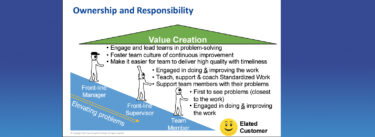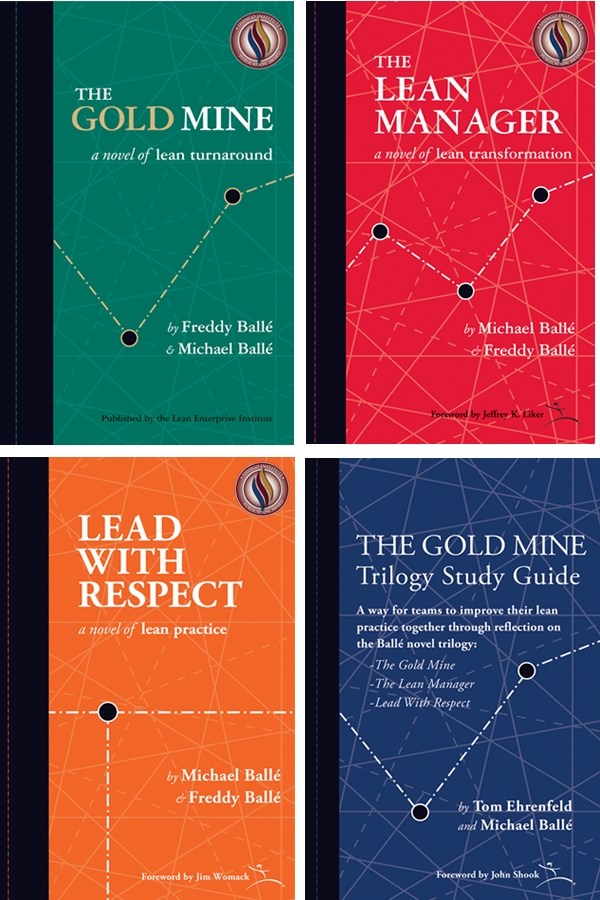Turner Construction’s CEO Peter Davoren has a reputation for spending much of his time at project sites across the company. For the CEO of the largest construction company in the United States, it’s admirable how much he prioritizes the gemba – the place where the value-creating work is done.
Over the years, he’s noticed a vast array of working environments. Some are “right” for the job to be done: projects are completed on time and under budget, people are safe and collaborative, absenteeism is low, and everyone seems happy. Whereas on other jobs, those with a “wrong environment,” everything is a constant struggle – no one seems happy. This led Peter to formulate a theory around what he calls the “right environment,” going so far as to declare “Creating the Right Environment” a strategic imperative for the company.
To his credit, Peter recognized that putting such a theory into practice would require leaders throughout the company to develop a clear understanding of what is a so-called right environment and a pragmatic way by which it can be created. So, he assigned David Robinson and Charlie Whitney, two general managers at the time, to figure out the what and the how. They would each lead a sort-of “model area” in their respective business units and eventually share their learning with their peers.
Laying the Foundation
“We started as you might suspect, by scratching our heads, trying to figure it out on our own,” Charlie told me during a recent conversation. “We asked ourselves, ‘What are the needed physical artifacts? What would we expect to see?’ Things like visualized project plans and installation tracking monitors were high up on our initial list.”
However, Charlie says, they quickly realized the need to move beyond tools into how they are used and “softer” categories like leadership, emotional safety, communication, caring, and support. “And ultimately, all of it – the system – proved to be the key to breaking the code of what contributes to the right environment on project sites, in departments, and with any team in general.”
“Although the ‘right’ physical space is important, I’d say it is not sufficient. If leaders do not actively engage with their team members – getting to know them personally, getting to know their work – our experience shows the right environment cannot be realized.”
What Charlie and David were discovering, as lean leaders have been discovering for decades, was the need for a socio-technical system to achieve transformation and sustainable performance at a high level. Having identified some technical and social components of such a system, their next step was to determine how to assess and improve it.
Every Team is Unique
In addition to the systems thinking they were developing, Charlie and David came to think about discrete teams like different families celebrating the same holiday. While the holiday is the same, let’s say we’re talking about Thanksgiving, how individual families celebrate it is unique to their traditions and preferences – their culture, if you will. (Thinking about my Tofurkey Thanksgivings with my vegetarian family, his analogy resonates with me.)
The system proved to be the key to breaking the code of what contributes to the right environment on project sites, in departments, and with any team. Instead of trying to implement a formulaic right environment for every project site, taking a “one-size-fits-all” approach, Charlie and David began facilitating “environment sessions.” Teams would define what was environmentally important to them, then self-evaluate their current situation. Specifically, teams were asked, “What needs to be present for the right environment to thrive?” Which was followed by, “On a scale of 1-10, how are you doing with each item?”
By assessing their current situation relative to their own target image, teams self-identified their gaps to close. Then they could decide on which experiments they would run to make things better. With this approach, ownership of the environment was with the folks who were working in it. Of course, people had always wanted a healthy and productive — a right — environment. They just did not have a method, and leadership support, for working on it.
“David and I were thrilled and relieved. It wasn’t entirely up to us. Plus, the ideas coming from the teams themselves were so much better than ours.”
And Things Keep Changing
While the environment sessions were proving to be effective, the dynamic nature of the industry required an ongoing approach. Charlie and David knew a “one-and-done” approach would be ineffective. Both salaried staff and hourly labor on jobsites are constantly being added and subtracted. Consequently, jobsite cultures are very fluid. Stability is not a hallmark of the industry. You could even say instability is the very nature of the industry. Where else is a worksite two stories today, and three stories a month later?
“Over time, we’ve identified risk factors to the right environment. One example is personnel changes. Another is safety – when someone gets hurt it has a big negative impact on a team. When one or more of these risk factors arise, it strongly suggests a follow-up environment session is needed. That’s our current countermeasure, and it seems to be working,” Charlie explained. “To me, this approach is PDCA for team management – something that was not previously discussed and definitely not measured.”
Personally, what I appreciate about the approach taken by Charlie and David, and eventually the rest of Turner’s leadership, is how principle- and process-based, yet situational it is. Combined with their ongoing efforts to develop capability enterprise-wide for problem-solving, improvement, and innovation in their people, processes, and systems – gemba- and A3-based improvement activities are proliferating across the company – Turner is creating an overall right environment, one project site at a time.
Peter set the strategic direction. David, Charlie, and other leaders are working to realize it in the daily work of the people they support.
*********
P.S. I reached out to Charlie because the challenge of connecting individuals’ daily work to their organization’s longer-term strategy has been on my mind. It’s the theme of the upcoming Virtual Lean Learning Experience (VLX) seminar which starts on June 21. LEI Senior Coach Mark Reich and senior leaders from Alaska Airlines, Quest Diagnostics, CI&T, and Nationwide will share how their companies are making everyone’s work more purposeful and better aligned.
I worked with Charlie a few years ago (Turner Construction has been a co-learning partner with LEI since the mid-2010s.) and remembered his involvement in the right environment initiative. If you, like Charlie and Turner Construction, are tackling this challenge, perhaps you will subscribe your organization to LEI’s ongoing VLX – a continuous education service for the latest in lean leadership and management.






